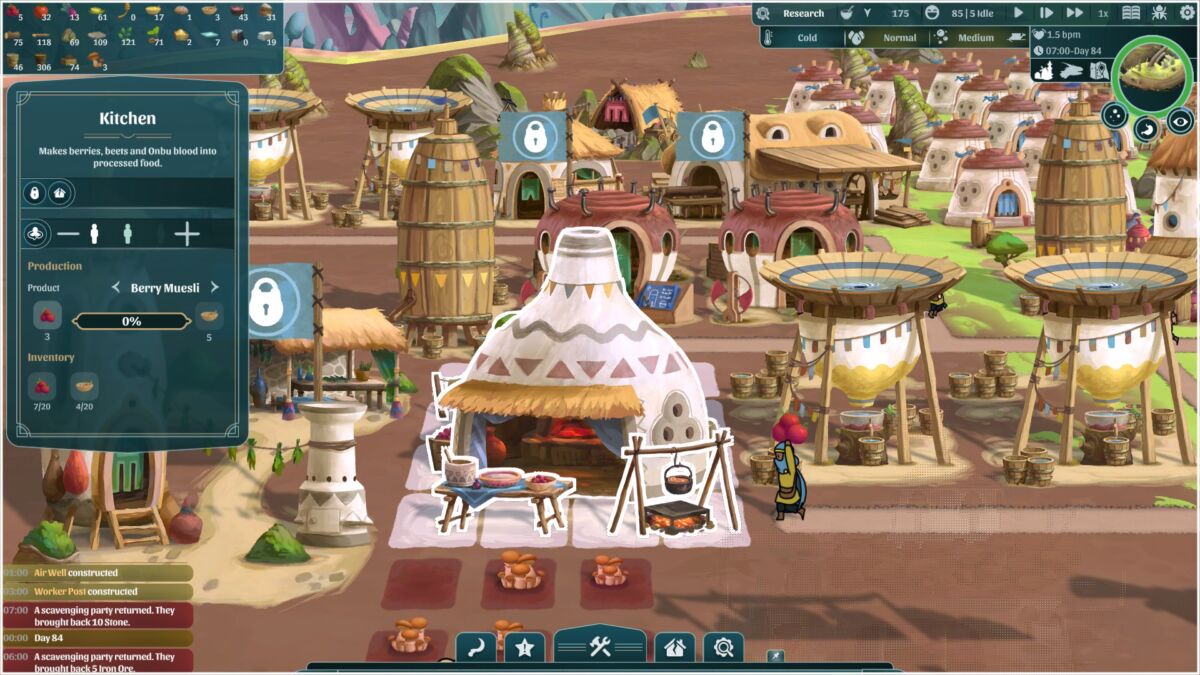If your people are the lifeblood of your settlement in The Wandering Village, then food is vital to keep your workers alive and happy. Maintaining a healthy base of food production will ensure long-term success in your playthrough. Here’s everything you need to know about food in The Wandering Village.
The Wandering Village Food Guide
Basic Foods

One of the biggest challenges you face in The Wandering Village is changing weather as you pass from one biome to another. That’s not even to mention the extreme weather phenomena you may encounter on your way. Each of the basic foods is uniquely set up to thrive in different weather conditions. Also, all food will be stored in an available pantry or food stand to shelter your delicacies from the elements.
The first of the basic foods are berries, which you can get from directly harvesting berry bushes or building a berry gatherer in a zone with dense berry growth for a consistent flow of berries. The biggest advantage of berries is that they’re unaffected by changing weather or different biome conditions. But, just like all other food and plant life, an invasion of poisonous and toxic plants can be deadly to your berry plantations.
Aside from the ability to harvest berries, your people start with the ability to plant and harvest beets from farm plots. Beets are great in moderate climates, but are also resistant to cold environments, though their growth rate does decline in cold weather. In hot climates beets will not grow and instead decay, so if you’re about to shift into a new biome, be sure to harvest all your beets before they decay away.
Corn, tomatoes, and wheat must all be researched before you can start planting and harvesting them. You can also research the ability to plant cacti, but they’re not a food and instead act as a plant-based source of water for hot biomes.
Corn is great in hot weather, though it generally grows quite slowly. Tomatoes are like beets in that they’re great in temperate biomes, though they are slightly resistant to heat, so can be paired well enough with corn. Wheat by itself isn’t a food when harvested and instead must be cooked to be consumed.
Cooked Foods

Speaking of cooked foods, basic foods can be processed in either the kitchen or the windmill and the bakery for wheat and will satisfy villager hunger more effectively, as well as give them a productivity boost. The cooked forms of berries, beets, corn, and tomatoes are essentially a form of soup or a grilled version of the basic food.
Wheat has the longest cooking chain, as you must first grow wheat, then mill it into flour, then have it cooked in the bakery into bread. The advantage of this long process, though is that you produce the most amount of bread per unit of flour compared to the other basic foods, so you can get large volumes going pretty quickly.
Finally, there’s one unique food that gives the biggest productivity boost but at the expense of the Onbu’s health and trust in you. You can research the ability to harvest Onbu blood and then cook it into black pudding in any kitchen.
There’s plenty of food to go around for everyone, but shifting weather conditions and traversing different biomes will make managing food quite the challenge. How will you stock up on food?
The Wandering Village is available on PC.
READ NEXT: 50 Best Strategy Games of All Time
Some of the coverage you find on Cultured Vultures contains affiliate links, which provide us with small commissions based on purchases made from visiting our site.

